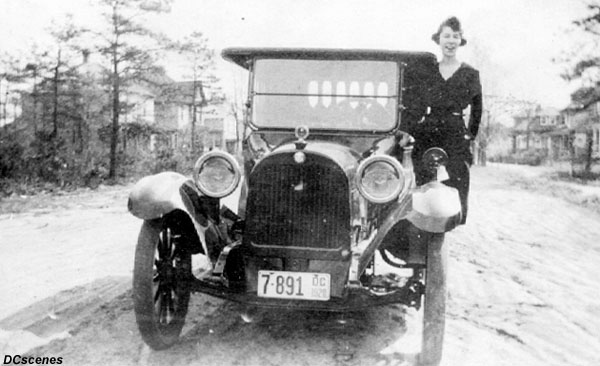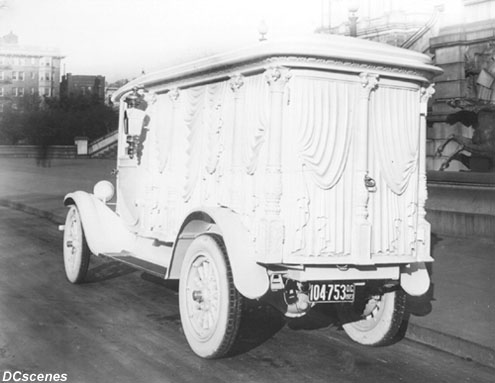License Plates and Registration Numbers
from January 1918 to December 1929
|
|
What is known about the numbering of District of Columbia license plates during this nine-year period is easy to understand, but there are mysteries, especially with respect to the numbering of non-passenger plates, that make this a confusing period. Passenger vehicle registration numbers are comprised of only numbers, assigned sequentially. Whether numbering began at 1, 101, or some higher number annually beginning in 1918 is unknown for some years, but plates 1, 2, and 3 are known to have been assigned to the District commissioners in 1922. Based upon this information, 1 is thought to have been the starting point for at least 1923-1926 (and later years, as well). As discussed in more detail in the appropriate year-by-year sections below, the first six-digit registrations (i.e. numbers 100-000 and above) are thought to have been assigned in 1923. The all-number format was abandoned after 1926, replaced by plates with a letter prefix, but it returned for the periods of 1935 through 1947 and 1966 through 1997. The mere existence of non-passenger plates, and their numbering, are a mystery due to their scarcity today. The few that are known feature letter prefixes and are identified in the appropriate sections below. |
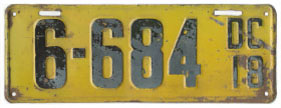 |
1918 |
 |
|
Washington, D.C. joined most of the states in 1918 when it switched to a system under which new, dated plates were issued to all vehicle owners annually. The (originally) bright yellow 1918 plates were issued singly, but all subsequent D.C. auto plates, with one exception during World War II, have been issued in pairs. Due to poor paint quality and having been made singly, 1918 plates are among the most difficult for collectors to locate in good original condition today. |
|
|
||||||||||||||||||||||||||||||||||||||
|
|
|
Passenger. Refer to the text above for an overview of registration numbers used from Jan. 1918-Dec. 1926. Specifically with respect to 1918 plates, the lowest and highest numbers observed are 2-484 and 38-079. |
|
1919 |
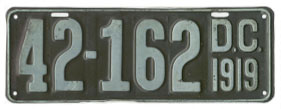 |
This is the first year for which Washington, D.C. license plates were issued in pairs. |
|
|
||||||||||||||||||||||||||||||||||||||
|
|
|
Passenger. Refer to the text above for an overview of registration numbers used from Jan. 1918-Dec. 1926. Specifically with respect to 1919 plates, the lowest and highest numbers observed are 1-323 and 44-713. |
|
1920 |
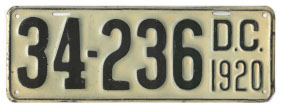 |
|
|
||||||||||||||||||||||||||||||||||||||
|
|
|
Passenger. Refer to the text above for an overview of registration numbers used from Jan. 1918-Dec. 1926. Specifically with respect to 1920 plates, the lowest and highest numbers observed are 100 and 54-343. The highest-number plates are similar in appearance to 1921 plates. |
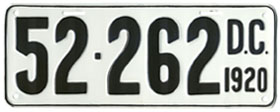 |
Based upon the appearance of embossed features on this high-number 1920 plate (which has been restored), we can assume that it was made towards the end of the year by the vendor that made the 1921 plates as opposed to the 1920 vendor. Presumably 50,000 sets (or some similar quantity) of 1920 plates were ordered from the original vendor, but that quantity proved to be not quite enough, so a relatively small number were ordered from the new vendor and issued towards the end of the year. |
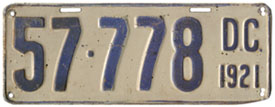 |
1921 |
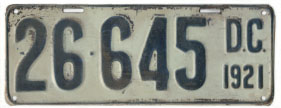 |
|
|
||||||||||||||||||||||||||||||||||||||
|
|
|
Passenger. Refer to the text above for an overview of registration numbers used from Jan. 1918-Dec. 1926. Specifically with respect to 1921 plates, the lowest and highest numbers observed are 7-401 and 66-561. |
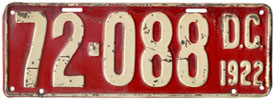 |
1922 |
 |
We don't know much about the assignment of registration numbers, particularly low ones, during this era, but a December 1, 1921, Washington Post article in which 1922 plates having gone on sale the previous day is discussed shines some light on the subject. This is our earliest evidence to indicate that at least some numbers perceived as low today, and probably also in the 1920s, were during this era set aside for particular groups of vehicle owners as opposed to being distributed randomly to rank-and-file D.C. residents. The Post story indicates that "Tags numbered from 200 to 500 have been reserved for the motor corps of the Home Defense league." Three-digit plates were routinely issued to diplomats and embassies, such as 190 to 197 provided to the Russian embassy. Number 747 went to the French embassy, the next two numbers to representatives of Romania, and 750 to the foreign minister of Ecuador. Numbers 1, 2, and 3 were assigned to the District commissioners, whereas some VIPs selected less noticeable numbers. Former president Woodrow Wilson, then out of office less than one year, requested and received a number that he had previously used: 39-955. Incidentally, Wilson is the only U.S. president to remain a resident of Washington after his term of service ended. |
|
|
||||||||||||||||||||||||||||||||||||||
|
|
|
Passenger. Refer to the text above for an overview of registration numbers used from Jan. 1918-Dec. 1926. Specifically with respect to 1922 plates, the lowest and highest numbers observed are 1 and 82-870. |
 |
1923 |
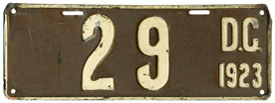 |
Nineteen twenty-three is the first year for which D.C. plates with numbers above 99-999 were ordered from the manufacturer (the identity of which is unknown). They had not been needed in 1922 or earlier years. The photograph below provides direct evidence of six-digit 1923 plates, and that plates numbered 100-000 and above were not needed or purchased in 1922 is confirmed by this passage from a May 1923 Washington Post article: "The District this year for the first time bought 100,000 license plates..." Although 1923 plates began to be issued on Nov. 15, 1922, presumably they could not be used until January 1. |
|
|
||||||||||||||||||||||||||||||||||||||
|
|
|
Passenger. Refer to the text above for an overview of registration numbers used from Jan. 1918-Dec. 1926. Specifically with respect to 1923 plates, the lowest and highest numbers observed are 1 and 111-959. |
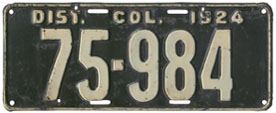 |
1924 |
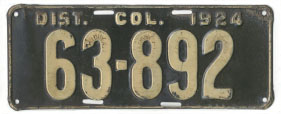 |
The layout of D.C. plates was changed in1924. Jurisdiction and year designations were moved to the top to more comfortably accommodate a sixth digit in the registration number, which was first required in 1923. Historically there has been some question as to the exact background color of D.C. plates of this year. Several sources erroneously list it as dark blue. Two separate 1923 Washington Post articles identify the 1924 color, and one of them states that distribution of the plates was expected to begin on Nov. 1, two weeks earlier than the previous year. Although the manufacturer of 1924 D.C. plates is unknown, a June 16, 1923, Post article indicates that 120,000 of them had been ordered. This is the first year that Washington, D.C. residents that operated their vehicles in Maryland did not have to also purchase a registration and display a set of license plates from that state. For information about this change, visit our Registration Reciprocity page by clicking here. |
|
|
||||||||||||||||||||||||||||||||||||||
|
|
|
Passenger. Refer to the text above for an overview of registration numbers used from Jan. 1918-Dec. 1926. Specifically with respect to 1924, the lowest and highest numbers observed are 1 and 90-474. |
 |
1925 |
 |
 |
|
|
||||||||||||||||||||||||||||||||||||||
|
|
|
Passenger. Refer to the text above for an overview of registration numbers used from Jan. 1918-Dec. 1926. Specifically with respect to 1925, the lowest and highest numbers observed are 1 and 113-377. |
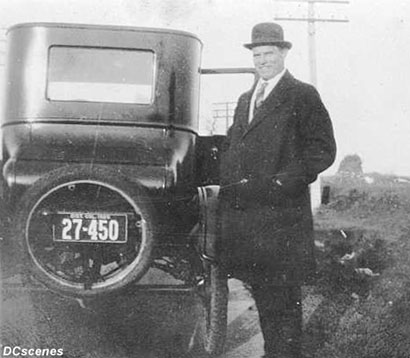
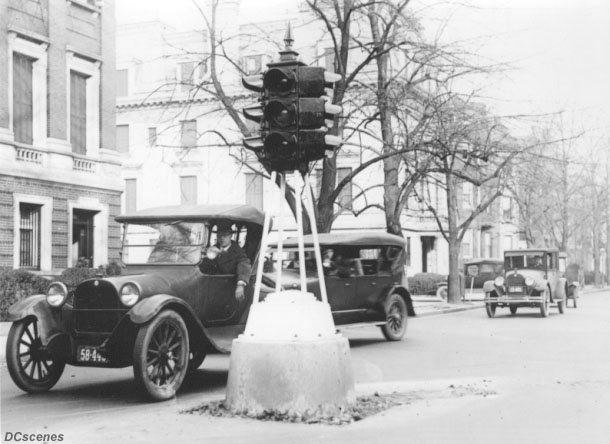
 |
1926 |
 |
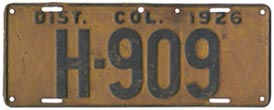 |
|
|
||||||||||||||||||||||||||||||||||||||||
|
|
|
Passenger. Refer to the text above for an overview of registration numbers used from Jan. 1918-Dec. 1926. Specifically with respect to 1926, the lowest and highest numbers observed are 1 and 111-544. |
|
|
Most District of Columbia license plates issued during the eight-year period from 1927 through 1934 include a letter prefix that indicates the registration type. Not surprisingly, the most letters were used to designate passenger car plates. Annually, however, plates with only numbers were also assigned, many of them to the same motorist year after year. These all-number plates were issued from 1 through 1000 in 1927, 1928, and 1929, and from 1 through 9999 from 1930 through 1934. The lowest plates of this era were assigned to those with status in the community, as discussed on our page devoted to reserved-number registrations. It is believed that the introduction of letter prefixes to D.C. plates was accomplished in order to avoid the continued need for six-number auto plates. In addition to the all-number sequences specified above, private auto plates of 1927 through 1934 are marked with certain letters followed by numbers 1 through 9999 (e.g. E-1 through E-9999). Although in most non-passenger cases the letter is in the first (prefix) position, the existence of 1931 truck plate number 2B-700 is evidence that when numbers of any type reached 9999 (e.g. truck plate B-9999), the type designation letter was moved one space to the right. Plates of at least one type, motorcycle, do not include a prefix letter (although they did in later years). Passenger. A Sept. 1926 article about the coming 1927 plates published in American Motorist by the local office of the American Automobile Assn. indicates that letters used on passenger plates during this era would be: E, F, G, K, M, N, O, P, Q, S, T, U, V, and W. However, today we know that there are errors in this data. For example, Y and Z (not mentioned in the article) also appeared on auto plates, as did J, which the article indicated would not be used due to its similar appearance with I, which was indeed not used. Plates beginning with O have not been observed and likely were never made or issued due to this letter's similar appearance to Q. It is important to point out that not all of the letters identified above as being available for use on auto plates were used in every year of this era. The order of introduction (and presumably issuance) of the letters appears to have been more or less sequential: E, F, G, J, K, etc. No N-series plates are known for 1927, 1929, or 1930, but their having been observed for 1928 suggests that this series was likely issued in sequence annually between M and P. There is some question as to in which year T was first used, as discussed in the 1928 section below. Q is known to have been used in 1927, but auto plates of no later years have been seen with this letter, suggesting that it may not have been used after that year. Non-Passenger. The American Motorist article referenced above also provides information about letter prefixes to be used to denote non-passenger plates. They are listed as follows:
In which year special plates for trailers were introduced is unknown, but the type designation is believed to have been TR. The earliest known is 1932. |
 |
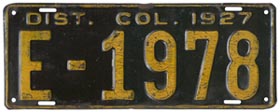 |
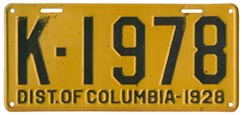 |
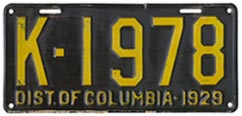 |
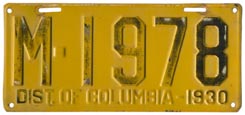 |
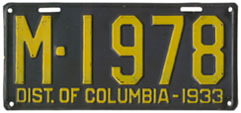 |
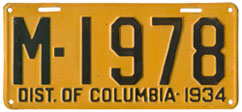 |
|
We interpret this collection of seven similarly-numbered plates, kept together for more than 75 years, to be en example of what happened to one D.C. motorist's registration when the issuance of four-digit numbers ceased for 1927. When the person to whom no. 1-978 was issued for 1926 was notified towards the end of the year that their number would not be used for 1927, he or she likely appeared at the DMV with a request for any general-issue number that included "1978." Perhaps their surname initial was M and it took them a few years to get the right letter with the right number. More broadly, we might simply speculate that the letter was unimportant, but that the motorist wished to retain the numeric combination. One wonders whether the person that used these plates tried unsuccessfully to regain number 1978 when numbers 1001 through 9999 were reintroduced for 1930. |
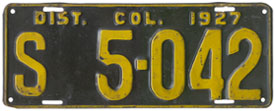 |
1927 |
 |
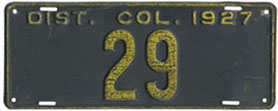
|
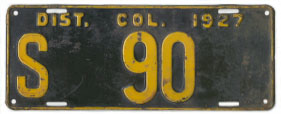 |
Based upon the existence of 1927 plates of two distinctively different styles (as to the registration number dies and manner in which the city name and year designation are displayed), the supply of required plates was apparently procured from two different manufacturers. Perhaps the most noteworthy change for this year, however, is the introduction of a letter to private passenger car registration numbers. Because the effect of this change was present for an eight-year period it is discussed separately above. |
|
|
||||||||||||||||||||||||||||||||||||||||
|
|
|
Passenger. These eleven prefix letters have been observed on 1927 auto plates (in conjunction with the new numbering format introduced for this year and discussed above): E, F, G, J, K, M, P, Q, S, U, and V. The highest observed number is V-900. If it is assumed that only eleven prefix letters were used on 1927 passenger plates and including the 1,000 plates without a letter prefix (numbers 1 through 1000), there are a total of 110,989 passenger registration number possible combinations. Based upon the highest registration number observed in several previous years being above 100-000, however, it appears that other prefix letters, perhaps N and/or W, may have been used in 1927. Regarding the two dies styles, all-number plates and plates of the E, G, K, and M series, as well as some P-series plates (including no. P-1613) have been found on the style represented by plate no. G-5593 pictured above whereas plates of the J, Q, S, U, and V series, as well as some plates of the P series (including no. P-8-502) have been observed with the 1926-style dies. Non-Passenger. Refer to the text above for information about to which non-passenger types plates with prefix letters A, B, C, D, H, L, R, and X were assigned. Non-resident plate no. X-24 has been observed. |
|
1928 |
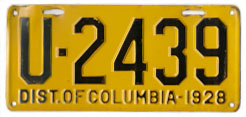 |
|
|
||||||||||||||||||||||||||||||||||||||||
|
|
|
Passenger. These ten prefix letters have been observed on 1928 auto plates (in conjunction with the numbering format introduced for 1927 as discussed above): F, G, J, K, M, N, P, U, V, and W. Based upon letter series used in 1927 it is reasonable to assume that E-prefix plates were also used for this year, and if this were found to be true there would be 11 passenger letter series for 1928. The highest observed number is W-8100. If it is assumed that 11 prefix letters were used on 1928 passenger plates and including the 1,000 plates without a letter prefix (numbers 1 through 1000), there are a total of 110,989 possible passenger registration number combinations. Based upon the highest registration number observed in several previous years being above 100-000, such as 111-544 in 1926, it seems that more than 110,989 combinations would have been required for 1928. In fact, the T series (registrations T-1 through T-9999) likely was introduced for 1928. Plates T-237 and T-4968 are known, and while plate collectors familiar with 1920s and 1930s U.S. plates may initially assume that a plate of this era with a T prefix was issued for use on a trailer, the existence of D.C. plates of this era with a TR prefix indicates that when special trailer plates were introduced here (the year being uncertain), the letter T was probably already in use on auto plates, necessitating the creation of a special prefix for the new non-passenger type. That the highest observed T-series plate is only number 4968 (whereas high four-digit registrations are known for plates of the V and W series, for example) suggests that T may have been the final passenger series to be introduced in 1928. If the full T series is included in the population of auto plates, the 12 letter-prefix series plus the 1,000 all-number plates would have allowed 120,988 possible passenger registrations. Whether the Q and S series were used for passenger plates in 1928, as they were in 1927, is unknown. Non-Passenger. Refer to the text above for information about to which non-passenger types plates with prefix letters A, B, C, D, H, L, R, and X were assigned. |
|
1929 |
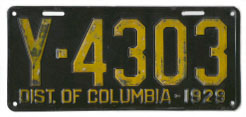 |
A Jan. 1929 Associated Press article about the assignment of low registration numbers (referenced here) indicates that "The license bureau expects to issue 141,000 tags in 1929, which means that in the District of Columbia there is one automobile for every three-and-a-half people. Also, it is estimated that 25,000 outside cars visit Washington every day." |
|
|
||||||||||||||||||||||||||||||||||||||||
|
|
|
Passenger. These twelve prefix letters have been observed on 1929 auto plates (in conjunction with the numbering format introduced for 1927 as discussed above): E, F, G, J, K, M, S, U, V, W, Y, and Z. Based upon letter series known to have been used in 1927 and 1928 it is reasonable to assume that N- and P-prefix plates were also used for this year, and if this were found to be true there would be 14 passenger letter series for 1929. The letter T (believed to have been used for auto plates in 1928 as discussed above) is thought to have not been used for 1929, it having been essentially replaced by one of the new series for this year, Y and Z. The highest observed number is Z-7470, although whether Z was the final series issued is unknown. If it is assumed that 14 prefix letters were used on passenger plates this year and including the 1,000 plates without a letter prefix (numbers 1 through 1000), there are a total of 140,986 possible passenger registration number combinations. Non-Passenger. Refer to the text above for information about to which non-passenger types plates with prefix letters A, B, C, D, H, L, R, and X were assigned. |
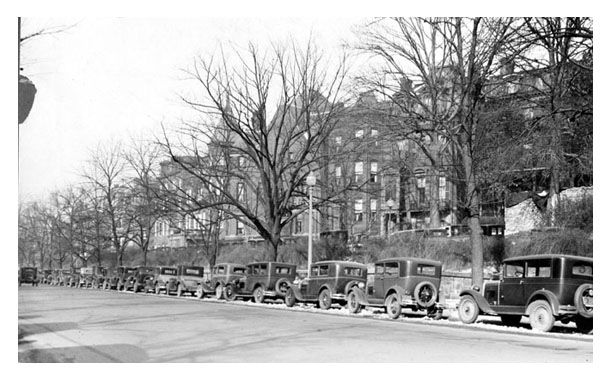
|
This page last updated on December 31, 2017 |
 |
|
copyright 2006-2018 Eastern Seaboard Press Information and images on this Web site may not be copied or reproduced in any manner without consent of the owner. For information, send an e-mail to admin@DCplates.net |















